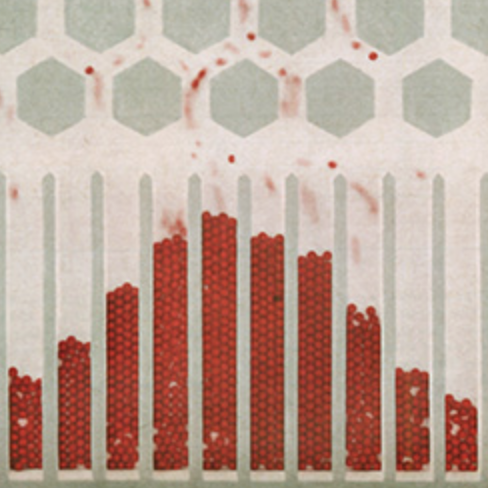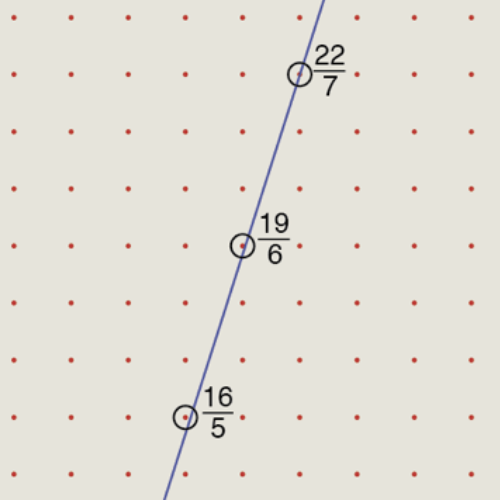The 39th Root of 92
by Brian Hayes
Published 6 August 2016
My new office space suffers from a shortage of photons, so I’ve been wiring up light fixtures. As I was snaking 14-gauge cable through the ceiling cavity, I began to wonder:  Why is it called 14-gauge? I know that the gauge specifies the size of the copper conductors, but how exactly? The number can’t be a simple measure of diameter or cross-sectional area, because thicker wires have smaller gauge numbers. Twelve-gauge is heavier than 14-gauge, and 10-gauge is even beefier. Going in the other direction, larger numbers denote skinnier wires: 20-gauge for doorbells and thermostats, 24-gauge for telephone wiring.
Why is it called 14-gauge? I know that the gauge specifies the size of the copper conductors, but how exactly? The number can’t be a simple measure of diameter or cross-sectional area, because thicker wires have smaller gauge numbers. Twelve-gauge is heavier than 14-gauge, and 10-gauge is even beefier. Going in the other direction, larger numbers denote skinnier wires: 20-gauge for doorbells and thermostats, 24-gauge for telephone wiring.
Why do the numbers run backwards? Could there be a connection with shotguns, whose sizes also seem to go the wrong way? A 20-gauge shotgun has a smaller bore than a 12-gauge, which in turn is smaller than a 10-gauge gun. Mere coincidence?
Answers are not hard to find. The Wikipedia article on American Wire Gauge (AWG) is a good place to start. And there’s a surprising bit of mathematical fun along the way. It turns out that American wire sizes make essential use of the 39th root of 92, a somewhat frillier number than I would have expected to find in this workaday, blue-collar context.
Wire is made by pulling a metal rod through a die—a block of hard material with a hole in it. In cross section, the hole is shaped something like a rocket nozzle, with conical walls that taper down to a narrow throat. As the rod passes through the die, the metal deforms plastically, reducing the diameter while increasing the length. But there’s a limit to this squeezing and stretching; you can’t transform a short, fat rod into a long, thin wire all in one go. On each pass through a die, the diameter is only slightly reduced—maybe by 10 percent or so. To make a fine wire, you need to shrink the thickness in stages, drawing the wire through several dies in succession. And therein lies the key to wire gauge numbers: The gauge of a wire is the number of dies it must pass through to reach its final diameter. Zero-gauge is the thickness of the original rod, without any drawing operations. Fourteen-gauge wire has been pulled through 14 dies in series.
As the rod passes through the die, the metal deforms plastically, reducing the diameter while increasing the length. But there’s a limit to this squeezing and stretching; you can’t transform a short, fat rod into a long, thin wire all in one go. On each pass through a die, the diameter is only slightly reduced—maybe by 10 percent or so. To make a fine wire, you need to shrink the thickness in stages, drawing the wire through several dies in succession. And therein lies the key to wire gauge numbers: The gauge of a wire is the number of dies it must pass through to reach its final diameter. Zero-gauge is the thickness of the original rod, without any drawing operations. Fourteen-gauge wire has been pulled through 14 dies in series.
Or at least that was how it worked back when wire-drawing was a hand craft, and nobody worried too much about exact specifications. If two wires had both been pulled through 14 dies, they would both be labeled 14-gauge, but they might well have different diameters if the dies were not identical. By the middle of the 19th century this sort of variation was becoming troublesome; it was time to adopt some standards.
The AWG standard keeps the traditional sequence of gauge numbers but changes their meaning. The gauge is no longer a count of drawing operations; instead each gauge number corresponds to a specific wire diameter. Even so, there’s an effort to keep the new standardized sizes reasonably close to what they were under the old die-counting system.
 Credit: WikipediaThe mapping from gauge numbers to diameters has two fixed reference points. At the thin end of the scale, \(36\)-gauge wire is defined as having a diameter of exactly \(0.005\) inch. At the stout end, a wire size designated \(0000\)-gauge is assigned a diameter of \(0.46\) inch. This quadruple-zero gauge is three steps larger than \(0\)-gauge (and might more sensibly be named \(–3\)-gauge). Thus there are \(40\) integer-valued gauge numbers, and \(39\) steps between them. The extreme values are known, and we need to devise some interpolation process to assign diameters to all the gauges between \(36\) and \(0000\).
Credit: WikipediaThe mapping from gauge numbers to diameters has two fixed reference points. At the thin end of the scale, \(36\)-gauge wire is defined as having a diameter of exactly \(0.005\) inch. At the stout end, a wire size designated \(0000\)-gauge is assigned a diameter of \(0.46\) inch. This quadruple-zero gauge is three steps larger than \(0\)-gauge (and might more sensibly be named \(–3\)-gauge). Thus there are \(40\) integer-valued gauge numbers, and \(39\) steps between them. The extreme values are known, and we need to devise some interpolation process to assign diameters to all the gauges between \(36\) and \(0000\).
The wire-drawing process itself suggests how to do this. Each pass through a die reduces the wire diameter to some fraction of its former size, but the value of the fraction might vary a little from one die to the next. The standard simply decrees that the fraction is exactly the same in all cases. In other words, for every pair of adjacent gauge numbers, the corresponding wire diameters have the same ratio, \(R\).
What remains is to work out the value of \(R\). If we start with \(d_{36} = 0.005\) and multiply by \(R\), we’ll get \(d_{35}\); then, multiplying \(d_{35}\) by \(R\) yields \(d_{34}\), and so on. Continuing in this way, after multiplying by \(R\) \(39\) times, we should arrive at \(d_{-3} = 0.46.\) This iterative process can be summarized as:
\[\frac{d_{-3}}{d_{36}} = R^{39}.\]
Filling in the numeric values, we get:
\[\frac{0.46}{0.005} = 92 = R^{39}, \quad \textrm{and thus}\quad R = \sqrt[39]{92}.\]
And there the number lies before us, the \(39\)th root of \(92\). The numerical value is about \(1.122932\), with \(1/R \approx 0.890526\).
With this fact in hand we can now write down a formula that gives the AWG gauge number \(G\) as a function of wire diameter \(d\) in inches:
\[G(d) = -39 \log_{92} \frac{d}{0.005} + 36.\]
That’s a fairly bizarre-looking formula, with base-92 logarithms and a bunch of arbitrary constants floating around. On the other hand, at least it’s a genuine mathematical function, with a domain covering all the positive real numbers. It’s also smooth and invertible. That’s more than you can say for some other standards, such as the British Imperial Wire Gauge, which pastes together several piecewise linear segments.
Who came up with the rule of \(\sqrt[39]{92}\)? As far as I can tell it was Lucian Sharpe, of Brown and Sharpe, a maker of precision instruments and machine tools in Providence, Rhode Island. A history of the company published in 1949 gives this account:
Another activity begun in the [1850s] was the production of accurate gages. The brass business of Connecticut, centered in the Naugatuck Valley, required sheet metal and wire gauges for measuring their products. Mr. Sharpe, with his methodical mind, conceived the idea of producing sizes of wire in a regular progression, choosing a geometric series as best adapted to these needs. Such gages as were in use prior to this time were the product of English manufacture and were very irregular in their sizes.
The first Brown and Sharpe wire gauge was produced in 1857 and later became the basis of an American standard, which is now administered by ASTM.
Wire gauges are not the only numbers defined by a weird-and-wonderful root-taking procedure. The equal-tempered scale of music theory is based on the 12th root of 2. A musical octave represents a doubling of frequency, and the scale divides this interval into 12 semitones. In the equal-tempered version of the scale, any two adjacent semitones differ by a ratio of \(\sqrt[12]{2}\), or about \(1.05946\). It’s worth noting that instruments were being tuned to this scale well before the invention of logarithms. I assume it was done by ear or perhaps by geometry, not by algebra. Around 1600 Simon Stevin did attempt to calculate numerical values for the pitch intervals by decomposing 12th roots into combinations of square and cube roots; his results were not flawless. What would he have done with 39th roots?
Another example of a backward-running logarithmic progression is the magnitude scale for the brightness of stars and other celestial objects. For the astronomers, the magic number is the fifth root of \(100\), or about \(2.511886\); if two stars differ by one unit of magnitude, this is their brightness ratio. A difference of five magnitudes therefore works out to a hundredfold brightness ratio. Brighter bodies have smaller magnitudes. The star Vega defines magnitude \(0\); the sun has magnitude \(-27\); the faintest stars visible without a telescope are at magnitude \(6\) or \(7\).
The idea of stellar magnitudes is ancient, but the numerical scheme in current use was developed by the British/Indian astronomer N. R. Pogson in 1856. That was just a year before Sharpe came up with his wire gauge scale. Could there be a connection? It would make a nice story if we could find some timely account of Pogson’s work that Sharpe might plausibly have read (maybe in Scientific American, founded 1845), but that’s a pure flight of fancy for now.
And what about those shotguns? Are their gauges also governed by some sort of logarithmic law? No, the numerical similarity of gauges for wires and shotguns really is nothing but coincidence. The shotgun law is not logarithmic but reciprocal. Wikipedia explains:
The gauge of a firearm is a unit of measurement used to express the diameter of the barrel. Gauge is determined from the weight of a solid sphere of lead that will fit the bore of the firearm, and is expressed as the multiplicative inverse of the sphere’s weight as a fraction of a pound, e.g., a one-twelfth pound ball fits a 12-gauge bore. Thus there are twelve 12-gauge balls per pound, etc. The term is related to the measurement of cannon, which were also measured by the weight of their iron round shot; an 8 pounder would fire an 8 lb (3.6 kg) ball.
Addendum 2016-08-08: Leon Harkleroad has brought to my attention his excellent article on “Tuning with Triangles” (College Mathematics Journal, Vol. 39, No. 5 (Nov. 2008), pp. 367–373). He describes a simple geometric procedure that Vincenzo Galilei (father of Galileo) used for fretting stringed instruments. In essence it takes \(18/17 \approx 1.05882\) as an approximation to \(\sqrt[12]{2} \approx 1.05946\).
Responses from readers:
Please note: The bit-player website is no longer equipped to accept and publish comments from readers, but the author is still eager to hear from you. Send comments, criticism, compliments, or corrections to brian@bit-player.org.
Publication history
First publication: 6 August 2016
Converted to Eleventy framework: 22 April 2025




I had to put it into Wolfram
I don’t know about wires, but with shotgun bores it’s like this: A 10ga bore indicates that it takes 10 solid lead spheres of that diameter to make a pound. So a 2ga bore would be shooting half-pound slugs, for example.
Slugs? Now we’re cooking with gravity. I’ll take my steak cut 1/12 the thikness of of a dead kings foot please.
Since a pound is legally defined as 0.45359237 kg, we can leave gravity out of it. (But my car does get 40 rods to the hogshead, and that is the way I likes it.)
Related to music theory, a more commonly known logarithmic scale is the decibel loudness scale which describes ratios of power (or similar quantities). The bel represents a ratio of 10, and therefore decibel represents a ratio of \(\sqrt[10]{10}\), which conveniently is approximately \(\sqrt[3]2\).
These logarithmic scales provide a nice way to work with logarithms without actually doing the logarithm calculation. For instance, the equitempered semitone scale gives a nice way to approximate products of some fractions with small numerators and denominators, which works by approximating ratios of logarithms of these fractions by fractions. (Whoa.) There are scales with 31 tones per octave, but I don’t think 39th roots will make any easier for composers to find harmonies.
I’m a piano tuner, and reading through the first section I was struck by the realisation that this is the second high-order root that I’ve encountered to do with pianos. Piano wire of course uses the AWG system with steel, with a smooth progression from about 14 gauge at the top down to about 21 gauge towards the bottom before the strings start getting wrapped in copper to add mass, including half gauges.
So I was pleased to see you describe the 12-ET tuning system. I felt special enough just knowing I worked with the 12th root of 2 in my daily life, now I know I also work with the 29th root of 92!
Also a log rule with “prefered numbers” (or Renard numbers) : https://en.wikipedia.org/wiki/Preferred_number
Thanks much for this! I am delighted to learn about “preferred numbers.” The Wikipedia article mentions several pertinent examples, such as resistor values, as well as f-stops and film speeds in photography. And the references include a link to a 1978 technical report from the National Bureau of Standards that has much more background and commentary, such as this:
Nice, I’ve been in the electrical industry for a long time, but never sat down to really work out the reasoning behind the AWG ratios. Mercifully, above wire size 4/0, they just use the actual cross-sectional area of the conductor, in kcmils (aka MCM), where a circular mil is the area of a circle with a diameter of 1/1000th of an inch. Easily convertable to other unit systems of course. I use a lot of 350 kcmil, 500 kcmil, and 750 kcmil cable.
Regarding instrument tuning, before the development of equal temperament, instruments were generally not tuned to equal temperament, but would select a temperament for the key the music was written in, usually resulting in integer ratios between the notes in the keys. The downside of this is that the instrument could only be tuned for a handful of keys at a time, because you can’t separate all 12 notes with integer ratios at the same time.
Stringed instruments could still play in multiple keys, but the musicians wouldn’t put their finger in the same place each time - they would play by ear, naturally landing on integer ratios, not equal ratios. A “C” in one key would be played at a different frequency than a “C” in another key, though in equal temperament they should be the same note.
When people learn to play a stringed instrument by ear, rather than formal instruction, they often have difficulty playing alongside pianos, because in equal temperament every note has a little error from the ideal ratio - that is the sacrifice for being able to change keys without retuning. This little bit of error was hugely controversial at one point, and resulted in everything from accusations of devil worship to threats of murder.
As someone who clearly likes to pull the veil back a bit, the world of temperaments could prove a deep rabbit hole for you.
So shotgun pellets are measured using a reciprocal scale. That’s how they measure nails, at least back when they had half-penny nails, ten-a-penny nails and so on.
Now I’m curious. I bought a stainless steel sink a while back. It was 18 gauge. Is that the same thickness as the diameter (radius) of 18 gauge wire?
Wire gauges and sheet-stock gauges are similar but not quite identical, with variations for ordinary steel, stainless steel, galvanized steel, and nonferrous metals.
The way I learned the rationale about wire gauges is that is that 40 gauge wire is almost
exactly one ohm of resistance per foot. 30 gauge is 0.1 ohms/foot, 20 gauge 0.01 ohm/foot and so on. The exact value is 1.049 ohm/foot, but 5% is close enough. So if you’re using 14-gauge wire to run a supply, that’s roughly 0.003 ohm/foot, so 100 feet is 0.3 ohms. If you put 10A through that wire, a common household load, you’ll lose 10 * 0.3 ohm = 3 volts. The wire resistance will then lose 3 volts * 10 amps = 30 watts.
While I totally get the reasoning behind using a geometric series, one still must wonder why select the 39th root of 92. Were I king I would select the 6th root of 2. (Or perhaps the 20th root of 10. )
A diameter ratio of the 6th root of 2 makes wire cross section double every 3 gauge sizes. With the AWG system this is approximately true, since 92^(1/39) ~= 2^(1/6) but exact is nice. Similarly 92^(1/39) ~= 10^(1/20) and using the 20th root of 10 means that every 10 gauges would mean cross section is 10x larger.
Both of the above ratios make exact one of the rough rules that the current AWG series approximates. If the diameter ratio selected were the 6th root of two, then every 3rd gauge would be _exactly_ twice the area (3ga would have _exactly_ twice the area of 6ga).
The 6th root of 2 as the basis of the series